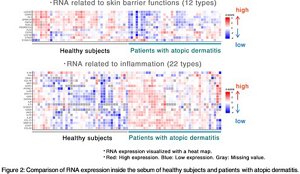Kao's original non-invasive analytical method for monitoring RNA
- Discovery of the presence of human RNA in sebum
The Bioscience Laboratory of Kao Corporation (Michitaka Sawada, President) has discovered the presence of human RNA (ribonucleic acid) in sebum and developed an original method called "RNA Monitoring" to enable the global analysis of RNA. Investigations by RNA Monitoring have shown for the first time that RNA expression information inside sebum reflects the disease state of skin affected by atopic dermatitis.
The results of this research were partially presented at the 118th Annual Meeting of the Japanese Dermatological Association to be held between the 6th and 9th of June, 2019.
* March 15, 2022 Additional Information
A paper on this subject has been published in Communications biology.
Inoue, T., Kuwano, T., Uehara, Y., Yano, M., Oya, N., Takada, N., Tanaka, S., Ueda, Y., Hachiya, A., Takahashi, Y., Ota, N., Murase, T. Non-invasive human skin transcriptome analysis using mRNA in skin surface lipids. Commun. Biol.5, 215 (2022).
https://doi.org/10.1038/s42003-022-03154-w
Background to the research
DNA has a double-helix structure consisting of four bases: adenine, guanine, cytosine, and thymine. Differences in the sequence of these bases bring about the myriad distinctive features - in facial appearance and physique, for example - with which every human being is born. RNA, on the other hand, serves as a template for the synthesis of proteins that perform various functions inside the body, such as enzymes or hormones, on the base of DNA information. Whereas DNA is unique to an individual and never changes throughout a lifetime, the profiles and quantities of RNA synthesized in the liver, skin, and other parts of the body differ in response to changes determined by a person's physical condition and the external environment from moment to moment.
From a dermatological perspective, DNA is useful for determining the innate features of the skin while RNA is useful for revealing the day-to-day changes in the skin condition in response to various environmental factors. The analysis of information on RNA expression in the skin, however, has been inconvenient to perform, requiring the surgical removal of skin in a highly invasive biopsy.
Technical developments to predict conditions inside the body using samples that can be obtained non-invasively, such as saliva and urine, have recently been advancing. Kao scientists believed that it should be possible to obtain detailed information on the skin condition at any given time by analyzing RNA expression information in the skin while taking the utmost care not to damage the skin. Given that skin reflects many of the conditions inside the body, RNA expression analysis, they hypothesized, could be an effective technique for gaining information on body conditions.
Construction of the RNA monitoring method
The stratum corneum and sweat can be obtained from the skin with relative ease. So far, however, the abundant presence of RNase, an enzyme that degrades RNA, in the skin, has made it difficult to obtain and analyze human RNA from the stratum corneum and sweat. Kao has been researching sebum and the sebaceous glands for many years. These glands create sebum and secrete it on the surface of the skin. Research on the sebaceous glands has tended to focus largely on the process by which the lipids that form sebum are synthesized. What little is known on the process of sebum secretion point to the existence of a special mechanism releases all of the ingredients inside the cells (holocrine mechanism). Kao scientists have closely studied this holocrine mechanism by which these ingredients are released. Their studies have suggested that sebum cells contain not only lipids, but also RNA.
Attempts to extract RNA from sebum with oil blotting film were successful, demonstrating for the first time that RNA is present in human sebum. Sebum was also found to inhibit the activity of the enzyme RNase which degrades RNA, indicating that RNA is more stable within sebum than outside of it. This finding led to the establishment of RNA Monitoring, a highly advanced method capable of analyzing up to 10,000 molecules of human RNA expression information (see Fig. 1).

Some applications of the RNA Monitoring method
Kao has been using this method to analyze RNA inside the sebum of both healthy subjects and patients with atopic dermatitis. The latter, patients with atopic dermatitis, have exhibited decreased expression of RNA important for maintaining the barrier functions of the skin and elevated expression of RNA linked to inflammation (Fig. 2).

Accurate assessment of the severity of atopic dermatitis is thought to be essential for the selection of an appropriate method of treatment. Various methods are now in use for this purpose, including the measurement of specific molecules inside the blood and blood cells. Previous studies have demonstrated that the expression of certain RNA obtained from skin biopsies rises in proportion to the severity of atopic dermatitis. The RNA Monitoring method developed by Kao has revealed a similar pattern of RNA expression. These results concur with previous findings related to the skin condition of patients with atopic dermatitis. Looking toward the future, the RNA Monitoring method is likely to enable the detection of variations in skin condition too subtle to observe by visual examination alone.
Future prospects
Given the ease with which sebum can be extracted, this method makes it possible to screen RNA expression information on the skin in a simple but highly precise manner. Future studies on how RNA information reflects relationships between the conditions of the skin and rest of the body will make it possible to propose beauty care tailored to individual skin conditions and ultimately health care tailored to other conditions of the body.
Media inquiries should be directed to:
Corporate Communications
Kao Corporation
